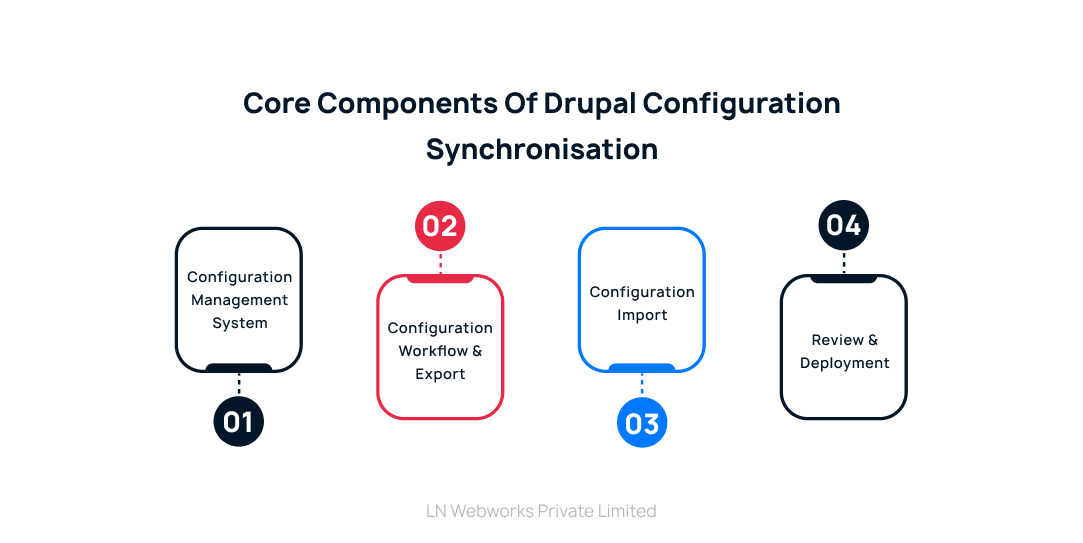Drupal Configuration Synchronization: A Simplified Guide

When you’re adding a new feature, like connecting your contact form to Mailchimp, on your Drupal website, you’ll want to make sure it works the same way when you move it from one stage to another. Luckily, Drupal has a handy feature called Configuration Synchronization for this.
This feature helps you easily export and import all the settings and setup between different copies of your Drupal website. In this blog post, we’ll take a closer look at how Configuration Synchronization works and some tips for using it effectively. We will also understand the best ways to make sure your Drupal development stays consistent across different environments.
What Do You Mean By Drupal Configuration Synchronization?
Drupal Configuration Synchronization is simply a feature built into the Drupal content management system that lets you organize and roll out changes to settings and other elements of your website across different environments. The Configuration Manager module is at the core of this feature, helping you handle all aspects of configuration, like site settings, content types, views, fields, and more.
Understanding what falls under “configuration” in Drupal is key. It encompasses the setup and arrangement of your site’s features, making it easier to manage and update them separately from actual content. With this being said, let’s have a look at the various components of Drupal configuration.
Core Components Of Drupal Configuration Synchronization
Let’s break down and understand the core components of Drupal configuration:

Configuration Management System
The Configuration Management System in Drupal is like its control center for managing configuration adjustments. It simplifies the process of moving configuration setups between different versions of a Drupal site. This systematic method ensures that settings and setups smoothly move from one environment to another, such as from development to staging or production.
The locations of configuration files are defined in the settings.php file. It’s a good idea to store these configuration files outside the main directory of your site for better organization and security.
Configuration Workflow & Export
The configuration workflow usually starts with making adjustments on a development site. After that, you export those changes and import them into other environments. The aim is to maintain uniform configuration across all environments for a consistent user experience.
Exporting configuration changes can be done through the Drupal admin interface or using Drush (Drupal Shell). The exported configuration is saved in YAML files, which are easy for humans to read and manage with version control. To export configuration files, you can use the command “drush cex” in your root directory. This command lists the configuration files you’ve modified, which will then be exported as YAML files.
Configuration Import
You can import the configuration into another Drupal instance, like a staging or production site, to ensure consistency across different environments. This import process can be carried out either through the admin interface or by using Drush. Using the command “drush cim” allows us to import all configurations from the development environment to the staging or production environment.
Review & Deployment
Make use of the Configuration Management Interface to carefully review and choose which configuration changes to deploy. This step is vital for ensuring that only desired changes are applied to each environment. Drupal offers features for monitoring and handling configuration adjustments. Through the Configuration Management Interface, you can assess and deploy configuration changes selectively.
To compare configurations across environments, you can access the comparison tool at this location: /admin/config/development/configuration.
Key Strategies For Drupal Configuration Synchronisation
Synchronization of Configurations Various strategies are used based on the needs of your project. One possible solution is a centralized method, in which configuration changes are made in a single main environment and subsequently synchronized with other settings. As an alternative, you may choose a distributed strategy in which every environment independently handles its own modifications.
Centralized Master Environment:
Set up a single main environment where all configuration changes are made. Then, synchronize these changes to other environments to maintain consistency across all levels.
Distributed Development:
Allow each environment to handle and sync its own configuration changes. This approach grants more freedom to individual teams, empowering them to work on specific project aspects independently.
Let’s Wrap It Up!
Drupal Configuration Synchronization is a useful feature that helps developers work on projects much more quickly. You may quickly streamline the Drupal development process by using effective tactics and following the appropriate methodology. Got a project in mind with Drupal?
At LN Webworks, our group of experts in Drupal are always prepared to help you make it happen. Get in touch with us right now to schedule a free consultation.